Saving Oldham's War Memorial
Jane Manners
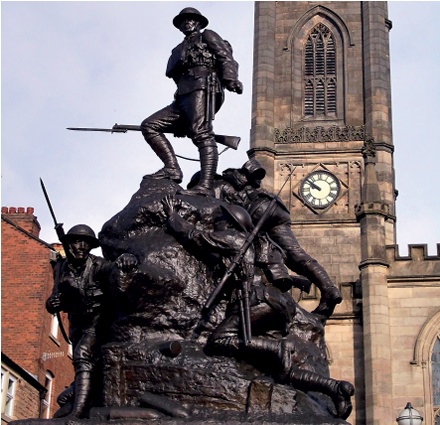 |
||
| The conserved and repaired memorial, which was rededicated at a special Remembrance Day service on 10 November, 2013 (All photos: Eura Conservation Ltd unless otherwise stated) |
Oldham War Memorial occupies a paved triangular space in the centre of this once thriving Lancashire mill town. The site is framed by a grand redbrick public house, the Greaves Arms, to the east and by the imposing neo-classical town hall to the south.
The parish church is immediately to the north and its entrance forms part of the memorial, with seven bronze plaques and three smaller ones set into its curved sandstone-clad walls. These plaques record the names of the dead from the first world war and subsequent conflicts.
A three-metre high granite base, surmounted by Albert Toft’s magnificent sculptural group, stands in the centre of the space.
A programme of conservation work carried out between May and August 2013 encompassed not only the memorial’s stone plinth and bronze sculpture but also a mechanical book of remembrance housed inside the plinth (illustrated below). The memorial plaques attached to the nearby churchyard wall, the wall itself and the approach to the church opposite the sculpture were also repaired and conserved.
Funding, coordinating and carrying out the project brought together a wide range of organisations including Unity Partnership (representing Oldham Council), the War Memorials Trust (WMT) and Oldham Liaison of Ex-Service Associations; conservation architects Lloyd Evans Prichard and main contractors Lambert Walker Conservation & Restoration Ltd; conservators from the University of Manchester and bronze specialists Eura Conservation Ltd. English Heritage’s consultant Richard Harris was brought in by WMT to advise.
Best conservation practice was followed throughout all procedures, with minimal intervention in line with Institute of Conservation standards, and every attempt was made to ensure that the bronze sculpture, the plaques and the churchyard were safely conserved for future generations. A full photographic record was also kept throughout all the processes, which should give future conservators invaluable insights into the 2013 project (a lack of detailed records of past treatment was a particular challenge during the recent works).
THE SCULPTURES
Albert Toft (1862-1949), the sculptor commissioned to produce the memorial, was born in Handsworth, Birmingham into a family of Staffordshire pottery artists. Toft’s father was Wedgwood’s principal modeller and Albert also served his apprenticeship with the firm.
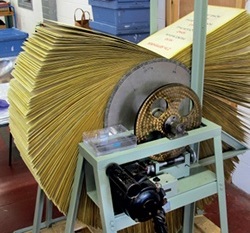 |
|
| The mechanical book of remembrance was removed from the plinth and taken to the University of Manchester’s Centre for Heritage Imaging and Collection Care. The pages were removed from the drum with the help of staff and students from Oldham Technical College then cleaned and repaired using Japanese tissue and a wheat starch paste. (Photos: The University of Manchester) | |
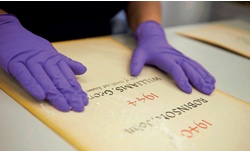 |
This early training may account for the cameo-like effect of some of his sculptural work. The plaque depicting the three Graces on Cannon Hill Park’s Boer War Memorial in south Birmingham, for example, has a remarkable delicacy and definition. His figures too, although they are frequently war memorials, have a delicacy and grace that belies the horrors of war.
After working at Wedgwood, Toft went on to win a sculpture scholarship to the South Kensington School of Art where his work was awarded medals in both his second and third years. Along with such notables as Hamo Thorneycroft and George Frampton, Toft is recognised as an important figure in the New Sculpture movement which, beginning in the late 19th century, challenged the dominant neo-classical style with a new naturalism.
Toft was already a well-established name in the art world by the time he was commissioned to commemorate the appalling losses of the first world war. Like many war memorials of this period, Toft’s sculptures tend to idealise the soldiers they portray. While soldier poets like Wilfred Owen and Siegfried Sassoon depicted men physically and psychologically maimed amid the squalor of the trenches, memorial sculpture typically presents happier and healthier images of young men prepared to die nobly for their country.
Toft’s sculpture for the Oldham memorial, set on its massive granite plinth, depicts four of these idealised soldiers, perhaps crawling out of the horror of the trenches to stand, victorious, aloft.
The memorial was dedicated in April 1923. The model for the topmost figure was also used for the Royal Fusiliers’ Memorial in Holborn, London which was unveiled the previous year, and another sister piece was cast for the memorial to the 41st Division at Flers, on the Somme battlefield. The Oldham memorial is the only composite piece.
Inside the granite plinth is a small room which was originally sealed by pairs of imposing bronze coffered doors on the north and south side. The south doors were later replaced with a viewing window which displays the book of remembrance, its pages turned daily by a special mechanism.
CONDITION
Toft’s bronze sculpture was in a sad state by the time conservation work commenced, with corrosion holes and active corrosion cells, and the surface was disfigured in many places by dark sulphides and leaching salts. Inspection also revealed cracks, casting flaws and holes in the surface where there were joints in the bronze. The whole of the sculpture had been cleaned, and possibly over-cleaned, in the past and a lacquer finish of unknown date and composition had been applied.
The most active corrosion was apparent where the lacquer had become degraded or worn, although there were also areas where porosity in the original casting had allowed material from the core to leach through to the surface. In several places there were large encrustations of salts and corrosion products forming a distinct disfiguring layer, with further corrosion continuing underneath.
There were also problems where the separately cast components of the piece had been joined. In places, the sections had been brazed in with copper, which was an entirely different colour, and there were areas where pieces of metal appeared to have been hammered in to fill gaps.
Water entering the sculpture through the original casting joints and through corrosion holes presented a problem for the room beneath, where the book of remembrance is displayed. The book was removed to be digitally recorded, conserved and temporarily displayed at the University of Manchester. In addition to working on the repair and reinstatement of the page-turning mechanism, conservators at the university also had to consider adding new pages to commemorate those killed in more recent conflicts.
CLEANING
The removal of the book of remembrance in early May 2013 allowed Eura’s staff to begin the process of testing appropriate cleaning techniques. It was decided to select a small area of horizontal surface not visible from the ground and closely examine the lacquer to determine its condition before carrying out cleaning trials on it.
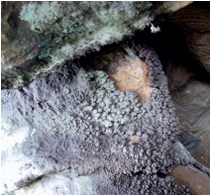 |
||
| Salts and other material which had leached from the core of the bronze formed thick encrustations in some areas. | ||
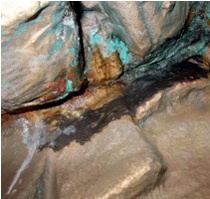 |
||
| Salt accretions with active corrosion (the green areas) and a band of black sulphide staining | ||
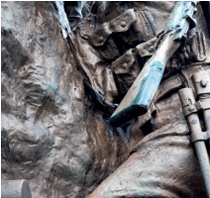 |
||
| Staining and pitting around a large, active corrosion hole which had penetrated to the core of the rifle butt | ||
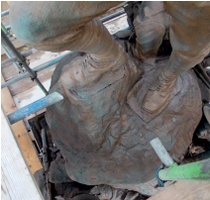 |
||
| Poorly sealed gaps at the feet of the topmost soldier where the castings had been joined together |
A lightweight scaffolding tower was used to gain access to the base of the bronze and an area on the south west corner was chosen for the trials. Micro-photos were taken of the selected area before and after testing to enable precise recording and assessment of each treatment.
The area was then cleaned using a one per cent solution of Triton X-100 non-ionic detergent, agitating with natural bristle brushes. The surface was swab-dried, rinsed with de-ionised water and allowed to dry. To the naked eye there was no apparent difference between the trial area and the surrounding metalwork, although it could be seen from the swabs that some soiling had been removed.
It was clear from the micro-photographs that the lacquer was thicker in some places than others, that the colour varied considerably and that green corrosion products were visible in many places. Examination of the surface also showed that the sculpture was greener where the lacquer was more severely degraded.
Once the trials had been completed the results were disseminated to all interested parties, including WMT and English Heritage, to allow for discussion of the best way forward. As the lacquer coating was clearly failing it was necessary to remove it, a conclusion supported by English Heritage’s consultant.
Further trials were carried out and the best results were obtained with a dichloromethane-based solvent. The use of dichloromethane has been heavily restricted under EU REACH (Registration, Evaluation, Authorisation and restriction of Chemicals) regulations since 2012. However, its use is sometimes necessary when removing historic treatments which weren’t applied with reversibility in mind and, if used carefully by conservators, it can safely remove coatings without damaging the substrate.
The memorial was completely scaffolded and screened for access and safety reasons. Further protection was added by laying a geotextile membrane (a permeable synthetic fabric) over surfaces to collect residues and to protect the local drains from the runoff of cleaning products and old lacquer.
The dichloromethane was applied with soft bristle brushes and swabbed off, and the bronze was thoroughly cleaned between coats with a high pressure steam cleaner, taking care not to damage any existing patina. Even with this treatment it took up to five coats in some areas to fully remove lacquer residues from sheltered crevices. All chemical residues were caught in the geotextile membrane and removed from site for safe disposal.
The removal of the lacquer coating allowed for further assessment of the surface and a photographic reference was made of problem areas.
While some loose corrosion products were effectively removed by repeated steam/ pressure washing, there were still areas of active corrosion, intractably stubborn salts and black sulphide accretions to deal with. Working closely with WMT and the other organisations concerned, it was agreed that the worst areas of active corrosion should be selectively and carefully cleaned further using the wet Jos method. Jos is essentially an air/water abrasive cleaning system which is suitable for removing active corrosion from bronze. In this case the medium used was marble dust (calcium carbonate) mixed with water and applied under pressure.
On bronze statuary, great care must always be taken by the operatives when using an abrasive system like Jos as it is possible to damage the surface of the bronze. For this reason, only a select group of highly experienced operatives and technicians was allowed to undertake the process. In addition, it was used as lightly as possible and only in those areas where it was absolutely necessary, with a small nozzle fitted to confine the spread of the medium.
Nevertheless, at the end of this process there still remained, in places, very thick coatings of salts or black sulphide deposits despite water/steam pressure of up to 80 bar and selective Jos treatment. So, the final stage in the process was the careful removal of these deposits by hand, using wooden spatulas, bronze spatulas and dental picks.
The whole sculpture was again fully washed and steamed before patination trials were commenced.
SURFACE REPAIRS AND PATINATION
Large holes and cracks in the surface of the sculpture were repaired with bronze mesh solidified with bronze-loaded resin. Smaller areas were filled with bronze-loaded resin or, wherever possible, with coloured microcrystalline wax.
All fixings on the sculpture were checked and any that were found to be ferrous were replaced with bronze threaded bar.
Of the two bayonets on the original sculpture, only one survived. As this one had to be removed to replace its ferrous fixings, the opportunity was taken to use it as a model for replacing the other. After testing for exact metal composition, a cast was taken, and the missing bayonet was then cast in bronze of a similar composition to the original. Once the finish of the rest of the bronze had been determined, the bayonet was cold patinated to match the surrounding metal. (Cold patination uses chemical compounds to achieve a given colour on bronze without the application of heat, which can burn off original patina.)
Achieving an even surface finish across the whole sculpture posed significant challenges due to colour inconsistencies in the brazing and original copper infills. The de-lacquered, cleaned but otherwise untreated green areas also had to be blended with the areas of bare metal where active corrosion had been removed.
Because the whole sculpture had been cleaned in the past, it was not possible to determine its original finish. Prior to conservation, the surface of the bronze was a relatively pale colour with no apparent chemical patination. However, from their work on several other Toft sculptures, Eura Conservation’s team suspected that it would have been chemically patinated originally, probably in a relatively pale colour.
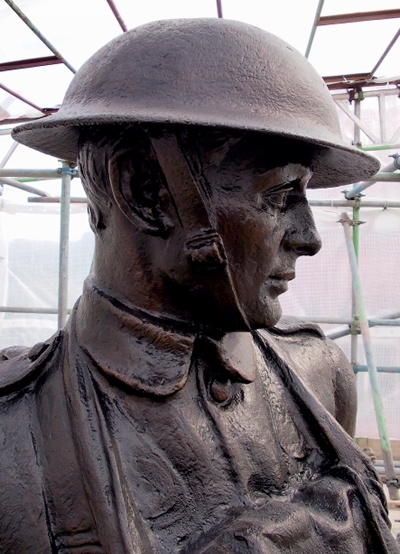 |
|
| A detail of Albert Toft’s Oldham War Memorial during conservation |
The patination chemicals trialled to blend in the various areas were potassium polysulphide, ammonia sulphide and ammonia. Small discreet areas were chosen for the trials that would be out of sight in the finished project. The results confirmed the conservators’ suspicions: it would not be possible to replicate the existing pale colour over the whole sculpture.
Again there were meetings on site of all involved, including WMT and English Heritage to decide the best way forward. The conclusion was that, in this case, the merits of a unified appearance outweighed the loss of the existing patina, so the whole surface would be chemically re-patinated using traditional methods.
After further trials, work began on restoring the finish. Cold or slightly warmed applications of potassium poly-sulphide were used, brushed back with the softest bronze brushes, if required. Several coats of the dilute chemical were needed, building up gently to a medium colour over the whole of the sculpture to achieve a finish consistent with other Toft memorials.
The features of the sculptural figures were very gently burnished to even up the patina and to achieve an attractive, slightly variegated mid-brown bronze colour. This highlighting achieves an aesthetically pleasing finish, bringing sculptured faces to life. A three per cent solution of benzotriazole in methylated spirits was then applied as a corrosion inhibitor.
The final treatment involved gently warming the sculpture and coating it with microcrystalline wax to ensure surface protection. Although wax does not last as long as a lacquer finish, it is considered preferable because it is readily reversible, relatively flexible and easy to repair and maintain.
It does require more frequent maintenance than lacquer but this can easily be achieved by regularly washing and re-waxing the sculpture. It does not present the same problems of differential corrosion as a lacquer does when it begins to break down or becomes chipped or cracked. Wax can also be used to even out porosity in the original casting and to fill small holes. Soft cloths were used to buff the wax to a light sheen to complete work on the sculpture.
Lambert Walker’s staff re-pointed the granite plinth, re-leaded the drains which take water away from the upper surfaces and sealed the edge of the sculpture. An anxious morning spent water-testing the whole structure led to sighs of relief all around.
Internal work to allow the re-positioning and lighting of the book of remembrance completed this part of the project.
Re-dedicated on 10 November 2013, Toft’s war memorial once more stands proudly above the town hall as a fitting tribute to those who lost their lives in the first world war and subsequent conflicts.
~~~
Recommended Reading
G Archer, The Glorious Dead: Figurative Sculpture of British First World War Memorials, Frontier Publishing, Norfolk, 2009
English Heritage, Practical Building Conservation: Metals, Ashgate, Farnham, 2012



